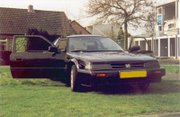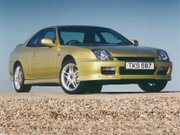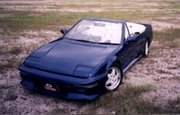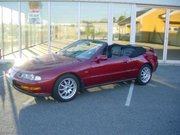The Honda Prelude
is a
front wheel drive four-cylinder
coupe that was manufactured by
Honda between 1978 and 2001. It spanned five generations
of cars but was discontinued upon the release of the
fourth-generation
Honda Integra in
Japan in late 2001.
The Prelude's perennial
competitor has been the
Toyota Celica, another four-cylinder coupe introduced
several years prior to the Prelude. Throughout the
1980s, which was known as the decade of inexpensive
sports cars, it was challenged by the
Nissan Silvia (180/200/240SX),
Isuzu Impulse,
Mitsubishi FTO,
Mitsubishi Cordia (later
Eclipse),
Mazda MX-6, and its cousin, the
Honda Integra.
1978
The first generation Prelude was released
in 1978 and had a
CVCC engine. It was the third main model in Honda's
modern lineup, joining the
Civic and the
Accord. Styling of the car was a combination of both
then current Civic and Accord.
Engine
- Type: CVCC Advanced Stratified
Charge, 4-cylinder, in-line, SOHC
- Displacement: 1751 cm³ (107 in³)
- Power: MT 72 hp SAE net @ 4500 rpm,
AT 68 hp SAE net @ 4500 rpm
- Torque: MT 94 lbf·ft @ 3000 rpm, AT
94 lbf·ft @ 3500 rpm
- Compression ratio 8.0:1
- Ignition system: Electronic
- Carburetion: 3-Barrel Downdraft
Carburetor
- Cooling: Liquid-cooled,
thermostatically controlled electric fan
Drivetrain
- Type: Front-Wheel Drive
- Manual Transmission: 5-speed, all
forward gears synchromesh
- Automatic Transmission: 2 manually
selected forward speeds with torque converter
Body, suspension and chassis
- Body Type: Unit body
- Suspension: 4-wheel independent,
front & rear MacPherson struts with coil springs and
integral shock absorbers
- Steering:
Rack and pinion
- Steering wheel turns, lock-to-lock:
3.26
- Brakes: Power assisted with dual
diagonal circuits
- Brakes - Front disc, self-adjusting
- Brakes - Rear drum, self-adjusting
- Tires: All-season 175/70 SR13
steel-belted radial ply blackwall
Exterior dimensions
- Wheelbase: 91.3 in
- Length: 161.4 in
- Height: 51 in
- Width: 64.4 in
- Tread: front 55.1 in, rear 55.5 in
- Curb weight: MT 2106 lb, AT 2110 lb
Standard features
- CVCC Advanced Stratified Charge
Engine
- Electronic ignition
- Front-wheel drive
- Four-wheel independent suspension
- Negative Steering Roll Radius
- Power-Assisted Front Disc Brakes
- Dual Diagonal Brake Circuits
- Steel-Belted Radial Ply Blackwall
Tires
- Bright Metal Wheel Trim Rings
- Power-Operated Moonroof with Sunshade
- AM/FM Stereo Radio with Unique
Controls
- Tachometer
- Electronic Warning System
- Maintenance Reminder
- Low Fuel Warning Light
- Digital Clock
- Cigarette Lighter
- Glove Box Light
- Two Speed Plus Intermittent Wipers
- Rear Window Defroster
- Side Window Defrosters
- Tinted Glass
- Rectangular Headlights with Snow
Drains
- Trip Odometer
- Day/Night Rearview Mirror
- Coin Box with Lid
- Stowage Boxes in Rear Seat Side
Panels
- Stowage Box in Center Console
- Fully Reclining Front Bucket Seats
- Full Carpeting
- Combination Light Switch on Steering
Column
- Inside Hood Release
- Remote Trunk Lid Release and Interior
Light
- Trunk Stowage Boxes
- Protective Body Side Mouldings
- Plastic Corrosion-Resistant Fender
Liners
- Vanity Mirror-R. Sun Visor
- Passenger Assist Handle-Right
Windshield Post
- Mud Flaps-Front Wheels
- Exterior/Interior Colors
- Tudor Red Metallic/Ivory
- Inverness Blue Black Metallic/Red
- St. Moritz Silver Metallic/Red
1982
The second generation
Prelude was released in 1982 and was initially available
with a 12-valve dual
carburetor engine, and
fuel injection was introduced in 1985. In Japan, Asia
and europe it was available with a DOHC 16 valve PGM-FI
engine allthough this engine was not seen until 1986 in
europe. This generation prelude was the first to have the
"pop-up" head lights. This allowed for a more airodynamic
front which reduced drag. Opening the headlights however,
especially at higher speeds, produces more drag and came
with a specific howl inside the car. As the car ages (all
cars with this type of headlights suffer from this) the
mechanics tend to wear out a bit and this makes for a
flickering headlight image, sometimes anoying others.

A 2nd-generation Prelude DOHC
16Valve
When the 16 valve DOHC
engine came out, you would also get a slightly modified
exterior since the larger engine could not be fitted under
the stock hood. A Prelude equipped with a 16 Valve engine
could be recognized by the slightly elevated part of the
hood which gives room for the cam gears (see picture on the
left. Note the elevated area on the right hand side). The
european version also saw slight modifications to the tail
lights and revised front and rear bumpers which were color
matched. (see picture on the right) Due to the fairly low
weight of the car (1025 kg) and high power (the 16 Valve
engine produced ~140HP) the car was surprisingly nimble,
something most Prelude's were not in comparison to their
competitors, until the VTEC engines came out.
1988

A third-generation Prelude on a
Road Course
The third generation
Prelude was built upon the success of the second generation,
however it gained
4 wheel steering (on some models), as well as a 2.0 L
SOHC carburetor engine, a
B20A DOHC EFI engine, or a slightly-larger B21A1 with
the second series in 1990 and 1991.
The four wheel steering
system on the third generation prelude was an extraordinary
piece of engineering in itself. It is the only 4WS system on
a production car that is entirely mechanical in its design;
That is, there is always a direct mechanical connection
between the steering wheel and the rear wheels. This means
the 4WS Honda was intuitive to drive, unlike every other
make 4WS system in which the rear wheels were controlled
indirectly by a computer.
The 3rd-Generation Prelude
had some new external designs worth mentioning. The hoodline
was designed to be the lowest hoodline of any FWD car in the
world allowing an unrivaled forward visibility that made
this Prelude a joy to drive. The drag resistance was at a
very low coefficient drag rating of .34. This gave better
fuel economy, lower wind noise, and a greater level of
high-speed stability. Another unique structural element of
the 3rd-generation Prelude is attributed thanks to the
high-strength metal used in the 6 pillars of the roof. These
pillars are so slim that all-around visibility is amazingly
clear for a whole 326-degrees and there are virtually no
blind spots. This makes for an airy feeling and further
enhances the driving experience of this Prelude. Some call
this Prelude 'The Baby NSX' due to some common design cues
between the two cars such as the excellent forward
visibility via low hoodline, a front-end resemblence, the
suspension attributes (great handling but also a smooth
ride), and the taillight design in the series-2 (1990 and
1991) models.
The Prelude was
Wheels magazine's
Car of the Year for 1987.
1991

A fourth-generation Prelude on an
autocross course
In 1991, there was a major
overhaul of the Prelude, released outside of
Japan in 1992. The four-wheel steering system was
changed to an electronic version and the engine was
increased in size from 2.1 L to 2.2 L for the base "S" model
(SOHC F22A1 engine, 135 hp (101 kW) @ 5,200 rpm, 142 ft·lbf
(193 N·m) @ 4,000 rpm) and "Si-VTEC"
model(DOHC VTEC H22A, 200 hp (147 kW) @ 6,800 rpm, 158
ft·lbf (214 N·m) @ 5500 rpm), with 2.3 L for the "Si" (DOHC
H23A1, 160 hp (119 kW) @ 5,800 rpm, 156 ft·lbf (212 N·m) @
5,300 rpm. In the UK there was also a 2.0i Model that had
around 125 bhp (93 kW).
This model also marked the
end for the pop-up headlights and a lot of other design
features that had become "prelude standard". The rear end
was no longer flat(low) and wide but wide, rounded and
fairly high in comparisson. The front end of the car became
wider with fixed headlights. The glass sunroof made way for
a steel sliding roof wich no longer rectracted into the car
(down and under the roof) but extended out and over. This in
effect creates a spoiler which does reduce the air noise
when driving.
The dashboard is generally
accepted as the extraordinary feature of this model. The
dashbord stretches from left to right in the car, beeing
equal in height over the full length and housing all dials
and indicators. The light blue backlighting introduced in
the 3rd generation was continued. Later models (1994 and on)
also featured translucent spedometer and tachometer needles.
In japan there has even been a in dash television set
available as a "stock" option. A lot of enthousiasts have
tried to build a display in the dash since.
1997

BB-chassis of a fifth-generation.
The fifth and final generation of Prelude
saw enhancements from the fourth generation, and in 2001,
the Prelude was discontinued.
The fifth-generation still
retained the
front-wheel-drive (FWD), front-transversal (FF) with
independent double wishbone with trailing arms & coil
springs with hydraulic gas-pressurized progressive valving
and variable power-assisted rack & pinion steering. All
fifth-generation Honda Preludes came with 6.5JJx16.0
aluminum alloy rims with all-season 205/50 R16 87V tires (or
tyres), except the Xi (5.5JJx14.0 steel wheels with full
wheel caps with 195/65 R14 89H tires) where aluminum alloy
rims came as a dealer option and the Si (6.5JJx15.0 aluminum
alloy rims with all-season 195/60 R15 88H tires.) The
fifth-generation Honda Prelude acquired a 63/37 weight
distribution. Unlike in the USDM, Japanese Honda Preludes
all had rear windshield washer wipers (except the Xi trim.)
|
The
fifth-generation Prelude marked a return to the body
style of the late
1980s Preludes (specifically the third
generation) in an attempt to curb slumping sales of
the fourth-generation body style. The
fifth-generation was assembled and distributed to
many parts of the world: Japan, the United Kingdom,
the United States of America, Canada, Germany,
France, Spain, Poland, Holland, Italy, Australia, et
al. All models and trims stayed within the
BB-chassis code (BB5-BB9) and either housed the
H-series motor or F-series motor for the most part.
In Japan, the models that were available ranged from
SiR (10.6), Xi (8.8), Si (9.2), SiR S-spec (11.0)
and the Type S (11.0). The United States of America
received a Base model and Type SH. Canada received
the Base model, SE, and Type SH. The European Union
and United Kingdom received the 2.0i (9.5) and 2.2
VTi VTEC (10.0). Australia received the Si (10.0)
and the VTi-R (10.0). All Preludes came with an
H22A( ) except: Xi (F22B), Si (F22B), 2.0i (F20A),
Si (F22Z), ( ). BB5 was the Xi, and Si-2WS trim. BB6
was the SiR-2WS trim, SiR S-spec, Type S, Base
model, Type SH, SE, 2.2 VTi VTEC-2WS trim. BB7 was
the Si-4WS trim. BB8 was the SiR-4WS trim, and 2.2
VTi VTEC-4WS trim. BB9 was the 2.0i. All Preludes
had a fuel tank capacity of 60 L (15.9 gal). |

Photograph of a Sparkle
Yellow Metallic (Y-59M) Honda Prelude
with Motegi optional rims.

A Honda brochure
photograph of a 1997-2001 Honda Prelude
Type S (BB6).
|
One version of the
fifth-generation Prelude, the Type S, was only available in
Japan. It was equipped with the
H22A, featuring
VTEC and producing 220 PS (162 kW, 220 HP) @ 7,200
rpm (U/min) and 22.5
kgf·m (221 N·m, 163 lb·ft) @ 6,500
rpm (U/min) at 2,156 cm³ (2.2 L). With a compression
ratio of 11.0:1, 87.0 mm bore x 90.7 mm stroke and the
VTEC-valve timing, lift and duration were also adjusted as
well to 12.2 mm|11.2 mm (intake|exhaust), Honda also
overhauled the air box and replaced it with a more efficient
design that is often referred to as Dynamic Chambering,
along with an increased throttle body design bored to 62mm
(as opposed to the previous 60 mm). The exhaust system also
was treated to a redesign as well, where the pipe design
became a more cylindrical shape rather an oval shape. The
3-way catalytic converter was also increased in size, as
well as the exhaust piping from 50.8 mm (2.00 in) to 57 mm
(2.25 in) (tToV). With the increased power output, the
suspension was also decked with 15 in. front ventilated
discs and 14 in for the rear. It weighs itself just in at
1,310 kg (2,882 lbs.) and had a ground clearance of 0.14 m
(5.5 in.). Unlike the SiR S-spec that had an LSD, the Type S
acquired the technology from Honda that is known as the
Active Torque Transfer System (ATTS) (other terms that
may be seen elsewhere that may come up are: DYCS [direct yaw
control system],
active yaw control system, Active Electronic Limited
Slip Differental [misnomer.]) The gearing on the Type S
matches all other fifth-generation Preludes that had a
manual transmission except for the 5-speed 2.2 VTi VTEC and
had a FD: 4.266. The Type S had an Active Control ABS
system, different from the others which had the standard ABS
systems. Inside, the interior, leather was present and was
laced with red-stitching. The seats could have lettering as
an option from the manufacturer. On the outside, the
exterior, the Type S was the only trim to not have a sun
roof as an option.

The
Active Torque Transfer System (ATTS).
There was only one other
car that housed the H-series, and it would be the last of
its kind until the presentation of the K-series. The Accord
Type R/Rx/Torneo (or the JDM version of the name more
commonly known as the Honda Accord Euro R) housed the last
line of a more refined H-series motor, which I believe to
have lasted from 1998-2002, until the exterior was revamped
and the K-series was introduced. The most common one, the
H22A7(/8?) is the most common one most people will hear
about (some of the other variation models housed the
F-series with 1,997 cm³ [2.0 L]). Just like the JDM
fifth-generation mate, the Type S, the Accord Type R
produced 220 PS (162 kW, 220 HP) @ 7,200
rpm (U/min) and 22.5 kg·m (221 N·m, 163 lb·ft) @ instead
of 6,500
rpm (U/min), it was 6,700
rpm (U/min) with a displacement of 2,156 cm³ (2.2 L).
With a compression ratio of 11.0:1, 87.0 mm bore x 90.7 mm
stroke, the engine was mated with a manual transmission in
which all gears are different from the brotherly JDM except
for the first gear. The Accord Type R also came with an
L.S.D (?).
The US-spec
fifth-generation Preludes also saw enhancements in the
engine, with the full line now offering VTEC H22A4 engines,
an evolution of the H22A1 with higher flowing heads, making
195 HP (195 PS, 143 kW) @ 7,000 rpm and 156 lb·ft (21.8
kg·m, 212 N·m) @ 5,250 rpm in 1997-1999, and the same torque
readings with 200 HP (200 PS, 147 kW) @ 7,000 rpm from
1999-2001 with a compression ratio of 10.0:1. The USDM
fifth-generation had a Type SH ("Super-Handling") trim which
featured the
Active Torque Transfer System (ATTS), and, along with
the 5-speed Base model, shared the exact same gearing from
the Type S and SiR-S spec trims in Japan (in which the Type
SH transmission is the exact same as the Type S.) This
system allowed Honda to overcome the front-wheel drive
limitation somewhat, and in 1997
Car and Driver named the Prelude Type SH the
"best-handling car under $30,000." The close of the history
of the Honda Prelude and its discontinuation will be
welcomed by the newer motor (along with the third-generation
Integra's end with the B-series motor), the K-series..

A Honda brochure photograph of a 1997-2001
Honda Prelude SiR (BB6/8).
Awards
The Prelude was on
Car and Driver magazine's annual
Ten Best list ten times, from 1984 through 1986, and
1992 through 1998.
Cabriolets
Throught the years several company's (all
German for some reason) have built cabrio versions of some
of the models Prelude. To this date there have been cabrio's
made from the 1st, 2nd and 4th model Prelude.

A top grade specimen 1st
generation prelude cabrio
The 1st generation Prelude was modified by
a company called Tropic Design, located in Germany. In all
they modified 47 Prelude's of which most were exported to
Japan and the US. Very few have remained in europe,
initially all in Germany. Some have been sold over time to
nearby countries, at least 1 to the Netherlands and one to
belgium.

2nd-generation Prelude cabrio in
a distinct 80's color
The 2nd generation Prelude was modified by
another German company; A. Stommel who called the model "Con
Moda" Some 100 were modified. To my knowledge none of the 16
Valve DOHC equiped cars were modified allthough it should be
possible to do this. 3 versions were available, a basic
verion, one which had more electrical luxuary and one which
added a spoiler and sideskirt kit, increasing it's optical
sportiveness allthough no engine modifications were made.

The only know 3rd-generation
Prelude cabrio
One 3rd generation Prelude cabrio exists
but very little is known about this car. We must asume it
has been a one time custom job.

4th-generation Prelude cabrio
Of the 4th generation Prelude, only some
15 were modified into a cabrio by yet another German
company; Honda-Autohaus Manfred Ernst (ME-Edition). Autohaus
is the German equivelent for "dealership". No details are
known about the engine types and other specifics. Since only
15 were ever made we can asume that they were highly custom
built cars.